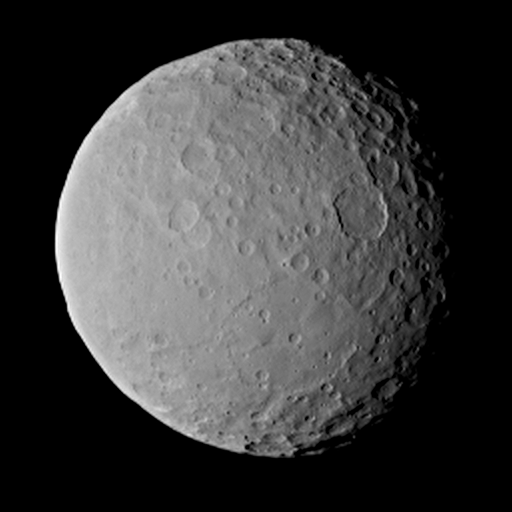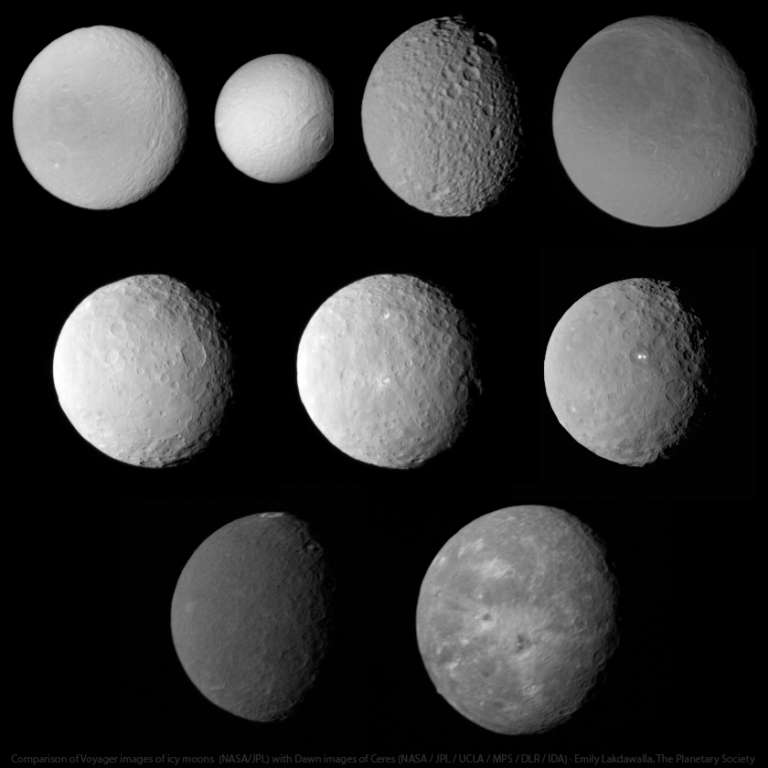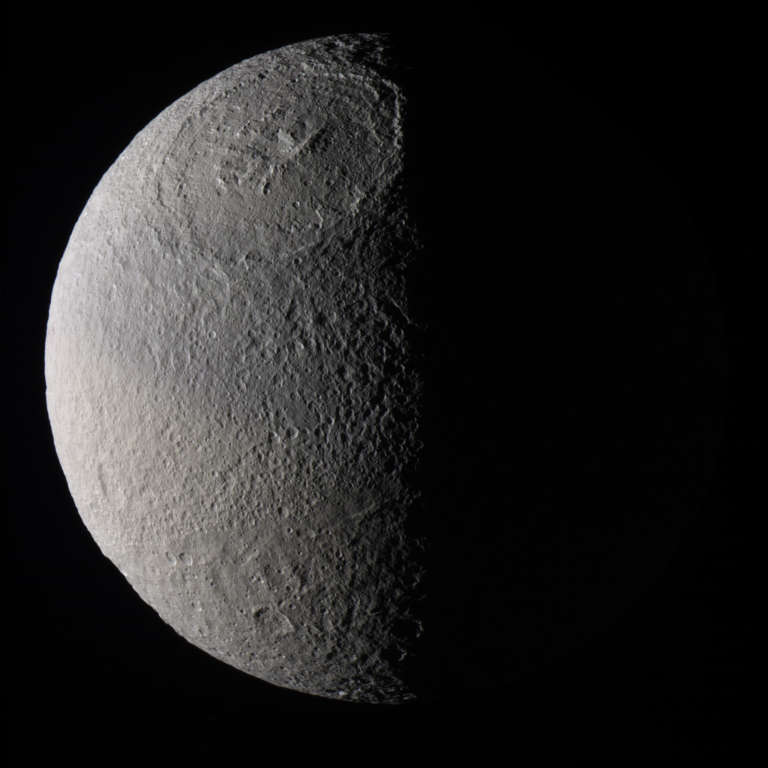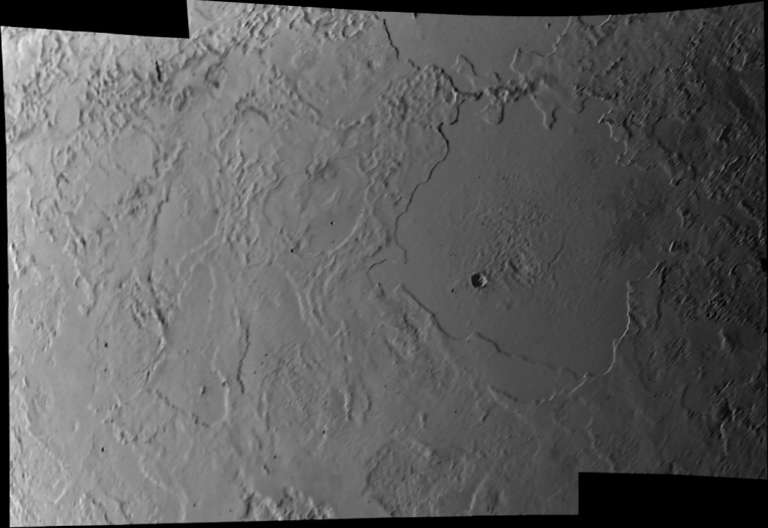Emily Lakdawalla • Feb 25, 2015
At last, Ceres is a geological world
I've been resisting all urges to speculate on what kinds of geological features are present on Ceres, until now. Finally, Dawn has gotten close enough that the pictures it has returned show geology. Before, we could clearly see craters; but everything has craters. Now, with the latest images taken on February 19, we can see the shapes of those craters, and begin to interpret what they mean about Ceres' interior and geologic history. But we shouldn't get carried away, because the images still have a pretty small number of pixels; at their original resolution, the visible disk is about 210 pixels wide.

In fact, before I even go in to any interpretation, I want to prime my analytical eye with images of other worlds we've visited at similar resolution. Dawn is seeing Ceres for the first time much the way that the Voyager spacecraft gave us our first images of the icy moons of the outer solar system as geological worlds. So I dug in to the Voyager archives and pulled out images of icy moons similar in size to Ceres, with similar numbers of pixels across their disks. Six of the pictures below are moons of Saturn and Uranus, and three of them are of Ceres. All are presented at their original resolution. Check them out and compare and contrast!
Ceres fits right in, doesn't it? I think the very first thing I've learned by putting together this comparison is that Ceres is a lot like the mid-sized icy moons of the outer planets. Yet, just like all those moons, it has its own unique personality.

The top row contains moons of Saturn as seen by Voyager: from left to right, Tethys, Tethys, Mimas, and Rhea. The middle row contains three views of Ceres. The bottom row contains moons of Uranus as seen by Voyager: Umbriel and Oberon.
Some things to keep in mind as you compare them:
- Size. The things pictured here come in three basic sizes. Mimas is smallest at about 400 kilometers diameter. Ceres, Tethys, and Umbriel are all roughly 1000 kilometers in diameter. Rhea and Oberon are about 1500 kilometers in diameter.
- Density. Tethys, amazingly, is less dense than water, so it has to be made almost entirely of water ice with some porosity near the surface. The rest of them have some rock, possibly as differentiated cores; the higher the density, the more rock. Mimas and Rhea are 1.2 times denser than water; Umbriel is 1.4; Oberon, 1.6; and Ceres, 2.1. Since Ceres is roughly twice as dense as Tethys and roughly the same size, its surface gravity is double that of Tethys'.
- Surface brightness. Ceres is darker than any of the moons. Its surface reflects only about 10% of the light that hits it, compared to 20% for Oberon and Umbriel, and 60%, 70%, and 80% for Mimas, Rhea, and Tethys, respectively. Exposed water ice is not stable for long periods on Ceres' dayside, because Ceres is much closer to the Sun than the moons are, which could explain the darkness; ice would sublimate away, leaving behind a surface lag of whatever other material is in Ceres' crust, including rocky and carbonaceous material, both of which are much, much darker than ice.
Okay, so what have I learned about Ceres by comparing it to these other moons? The first thing that you notice about Ceres has to be its bright spots. One of them is so bright that it was visible to Hubble. Dawn's camera has now resolved that brightest spot as two distinct bright spots within a crater. There are other bright spots elsewhere within craters. Those bright spots are fascinating; that extra bright pair is particularly eye-grabbing. Do remember that everything is relative, and Ceres' surface is really dark, so the bright spots don't have to be pure white, they could just be, say, Mimas-colored, or Rhea-colored. Whatever color they are, they are brighter than anything else on Ceres, and still too small for the camera to resolve them.

The bright spots generally seem to have an association with craters, so I'm going to assume that they resulted from an impact exposing subsurface, brighter material until I see evidence to the contrary. I won't speculate on what that material is until Dawn gets closer. But we still don't know what is happening on Ceres yet, and have to keep open the possibility that they are volcanic. Why do I prefer the crater interpretation to the volcano interpretation? It's about my geological bias. it would be much more exciting for the bright spots to be volcano-related than crater-related; I really want it to be true that they're volcanic, because then there'd be a more exciting geologic history story to tell. So I have to calibrate my interpretation by dialing down my suspicion that they're volcanic, and insisting mentally that they must be impact-related until someone shows me incontrovertible evidence that they are volcanic. And then I will let myself be excited about volcanism on an asteroid!
Here is a little group of things that I found interesting in the Ceres images. The top row -- images (a) through (d) -- contains bright features, some of which seem to be surrounded by darker material. Hmm.
Ignore the bright spots, and what do I notice next? The craters. There are lots of them, as there are lots on all the icy moons. Many of the smaller craters on Ceres are bowl-shaped, but the bigger ones have noticeably flat floors, like the ones on Tethys and Rhea. In the picture above, the two craters on the left, (e) and (f), look a lot like those on Rhea or Dione: they have steep rims, but flat floors, a hint of a central peak, and a hint, also, that the craters aren't perfectly round. On Rhea and Dione, we think that the non-roundness of the craters is caused by the existence of fractures in the crust; those fractures were zones of weakness, and the rupturing of the impact crater followed those weaknesses, making straight rim segments.
But there's one crater on Ceres that made my jaw drop: it's the big one at the center of the view above, (g). It's incredibly flat. You can barely see its rim. Its interior is very smooth and lacks any mid-sized craters, though there are many small ones. On the Max Planck website, they go so far as to say that the large crater is relatively recent, because it contains no middle-sized craters, only small ones.
The main question about such a flat crater, other than its age, is: was it born that way, or did it become flatter over time? On icy worlds, initially deeper craters become shallower when, over geologic time, the warmer ice in the world's interior flows from high places to low places, raising crater floors. But a layer of ice at the surface is so stiff that it still preserves the pre-impact topography. That's how Tethys' huge Odysseus basin still has a rim, a peak ring, and a central peak, even though its floor has risen over time so that it is now convex, continuing the curvature of Tethys' globe rather than concave, like the original bowl shape of an impact crater:

But Ceres' largest visible basin is much, much smoother than Odysseus. There is no pre-impact topography present -- no peak, no peak ring. What happened to the topography? Was it covered up by a volcanic flow, like lava flows filled in the lunar impact basins? Or was there never much any topography in the first place, because the impact happened long ago into a Ceres with a thin crust and a subsurface ocean? These kinds of features are called palimpsests; they don't exist on the mid-sized outer planet moons, but you see them on Europa and Ganymede. The round basin on Ceres is so incredibly smooth that I'm inclined to think it's been filled in, like the terrain in the photo of Triton below, but -- like I said before -- I'm going to remain doubtful of volcanism until I'm left with volcanism as the only interpretation. And we haven't gotten there yet.

Is there anything besides impact features on the surface? What about tectonic features, places where the crust has fractured, faulted, folded? It's not obvious; here, we're reaching the limits of the resolution of these latest photos. But a sharp-eyed viewer at unmannedspaceflight.com noticed what appear to be two parallel, linear grooves at the edge of the disk, topography revealed by the low-angle lighting (h). There's even a hint of a third groove running perpendicular to the other two. All of Saturn's icy moons have cracks and grooves; maybe this is another way in which Ceres is a cousin to Tethys!
Or maybe not. The resolution is not quite enough to say for sure. We'll know better in April. As Marc Rayman explains in his most recent blog entries (January and February), the February 19 pictures are some of the best Dawn will have for several weeks, as the spacecraft is overshooting Ceres by a bit, traveling farther away and to the night side of Ceres before Ceres' gravity finally grabs it. The crescent views we'll get of Ceres from its night side will be really cool but probably won't reveal a ton more about its geology. As with so many things I predict about space exploration, I would be truly delighted to be wrong! Which is good, because I almost certainly am wrong about much of what I said here!
Support our core enterprises
Your support powers our mission to explore worlds, find life, and defend Earth. You make all the difference when you make a gift. Give today!
Donate

 Explore Worlds
Explore Worlds Find Life
Find Life Defend Earth
Defend Earth

